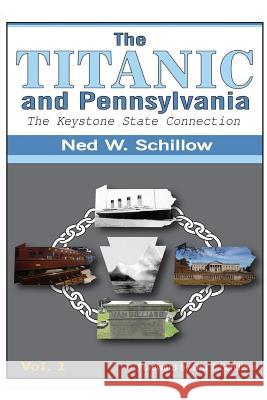The Titanic and Pennsylvania: The Keystone State Connection Volume 1 » książka
The Titanic and Pennsylvania: The Keystone State Connection Volume 1
ISBN-13: 9781518618789 / Angielski / Miękka / 2015 / 428 str.
The Titanic and Pennsylvania: The Keystone State Connection Volume 1
ISBN-13: 9781518618789 / Angielski / Miękka / 2015 / 428 str.
(netto: 69,00 VAT: 5%)
Najniższa cena z 30 dni: 68,41 zł
ok. 13-18 dni roboczych.
Darmowa dostawa!
The Titanic: pride of the White Star Line, the largest ship of its day boasting exceptional rooms and impressive meals, but destined for disaster. Pennsylvania in 1912: rich in history, home to society's finest and hard-working laborers, upscale department stores and back-country vendors, Main Line mansions and rural farms, and excellent public transit and horse-drawn carts. Volume 1 contains the stories of 101 persons aboard the Titanic who were heading to Pennsylvania, either returning home or immigrating to the state, along with a very fortunate family of four who were not permitted to board the ship. Here also are the tales of 14 more Titanic travelers who were born in the state but had moved away by the time of the sailing. This history is a sweeping saga that touches at least 18 other states and 15 nations in a nearly unbelievable encounter with fate. The Titanic and Pennsylvania: The Keystone State Connection, volume 1, provides biographical accounts of passengers on the Titanic who had clear ties to Pennsylvania. These persons are organized into chapters by by class or status, and individual sections include biographical sketches of the families or individuals, providing greater detail about their backgrounds, experiences on the ship and during the disaster, and their lives after the sinking where applicable. The Introduction covers Clement Action Griscom, first president of the International Mercantile Marine, and the path that led the White Star line to build the Titanic. Chapter 1 briefly summarizes the Commonwealth of Pennsylvania in 1912, both in terms of general living conditions as well as financial and industrial perspectives. Chapter 2 tells the story of the journey and sinking of the Titanic, including the rescue of the fortunate survivors. While the general history is familiar to most, the use of quotations from the writings and interviews of Pennsylvania-related passengers help move the details forward in a personalized manner. Chapter 3, the longest in the book, explores the first class passengers aboard the ship who were heading home to Pennsylvania after traveling abroad. Also included is a brief summary of life aboard this ship for these upper crust individuals and the specialized amenities offered to the first class passengers. Chapter 4 switches to the maids and valets of these persons who were also aboard the Titanic, serving the needs of their employers during the journey home. Chapter 5 summarizes the second class Pennsylvanians who were returning home to the state, and chapter 6 does the same for their counterparts in third class. Each chapter begins with pertinent details about what life was like aboard the ship for each of those classes. Chapter 7 switches to general details about what it was like for immigrants coming to the United States aboard the Titanic and then particularly focuses on those who were heading to Pennsylvania. For the most part, these immigrants were planning on working in the steel mills, establishing stores or shops, or joining their families who were already in America. Among the particular sections in this chapter is one that emphasizes the Finns who were heading to work in the mills of the Monessen Valley, another on the Bosnians and Croats seeking employment at the steel plants in Harrisburg, and one on the Lebanese Syrians who were generally planning on setting up shops or selling produce in Wilkes-Barre. Finally, chapter 8 looks at those other passengers who were unarguably Pennsylvanians from the perspective of where they were born but who had moved out of state some time before 1912. Appendices are included citing sources and listing Pennsylvania-linked passengers and non-passengers who are tied to the Titanic story. This book is the first of a two volume series, with the second volume looking at other passengers aboard the Titanic who had connections to Pennsylvania other than those just mentioned above.











